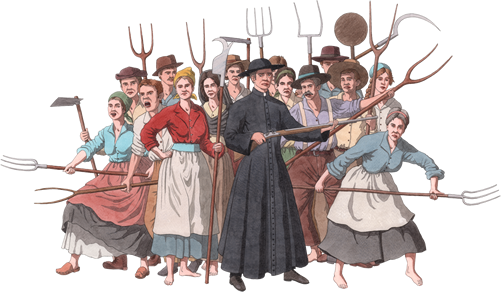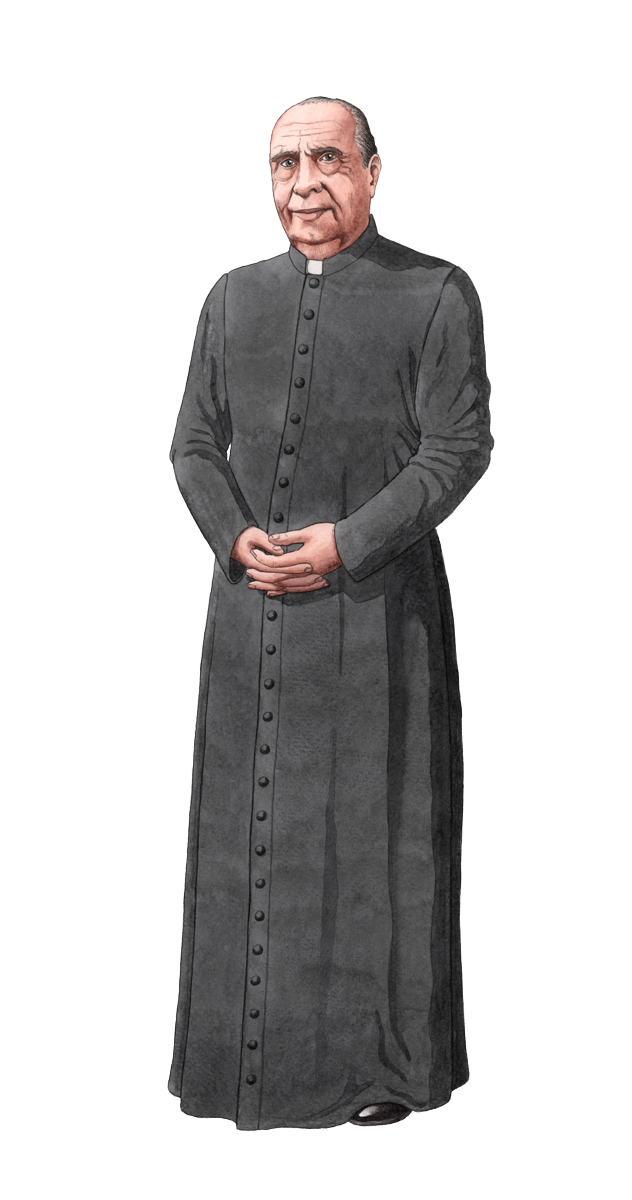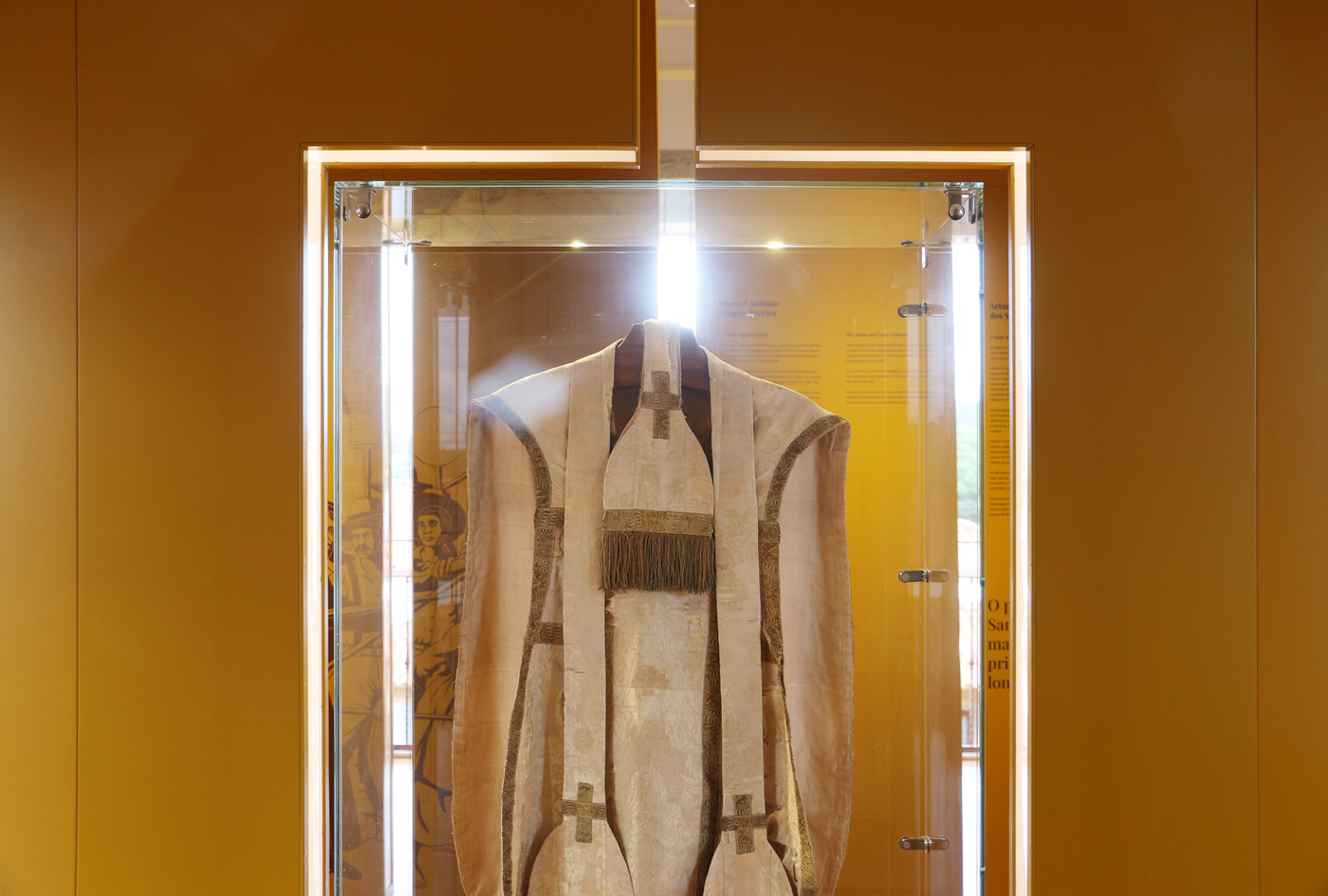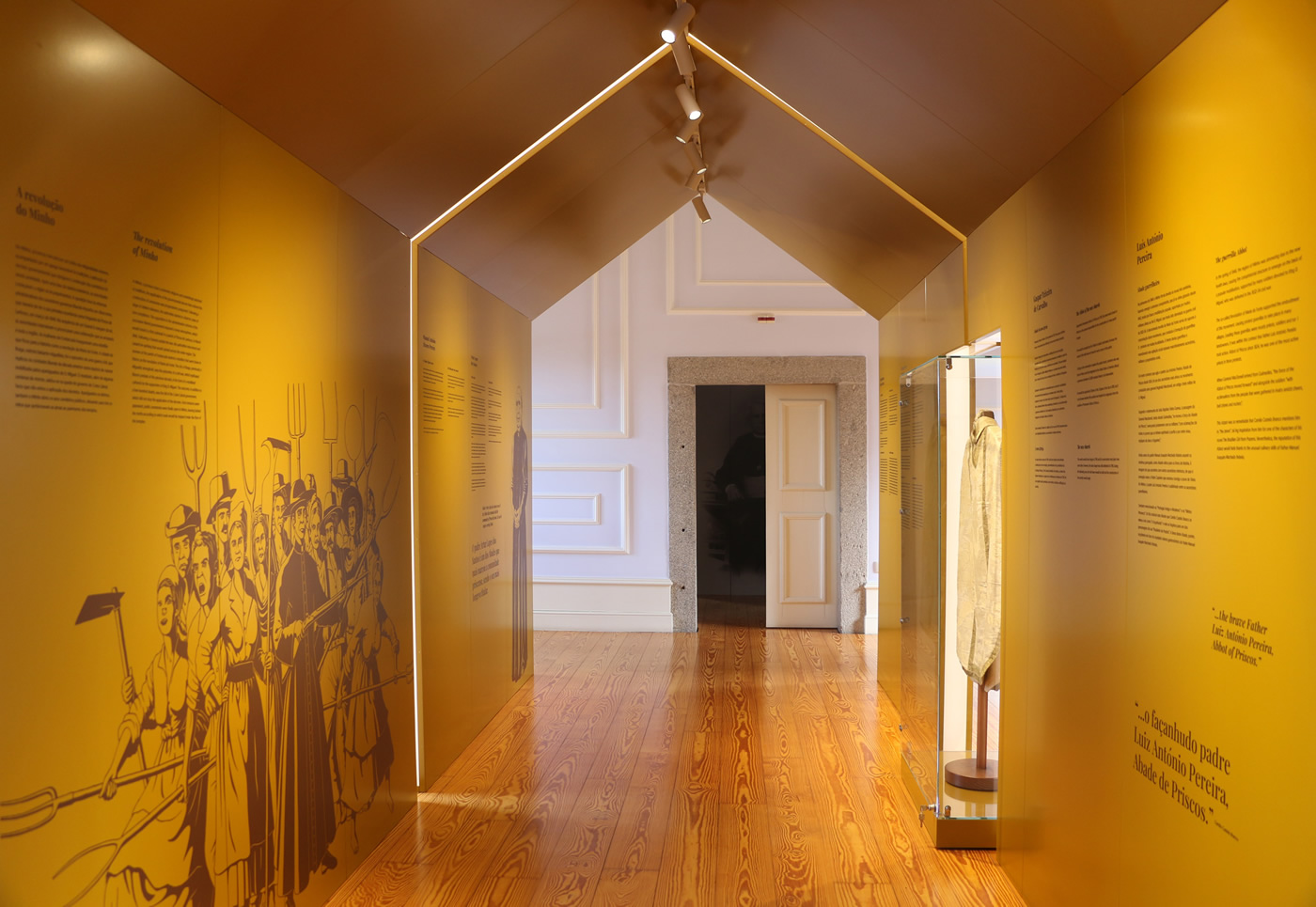THE ABBOTS OF PRISCOS
THE ABBOTS OF PRISCOS
THE ABBOTS OF PRISCOS
The Abbots are the main characters behind the history of Priscos. This land is essentially known for the feats of its successive titular priests, whether for their arms, the wooden spoon or the manger.
The Abbots are the main characters behind the history of Priscos. This land is essentially known for the feats of its successive titular priests, whether for their arms, the wooden spoon or the manger.
The Abbots were the titular priests of the parish of Priscos, and their ancestry dates back, at least, to the 11th century. Today, based on the existing documentation, we have a better overall knowledge of its titular priests since the 16th century. However, many other names are still hidden in the oblivion of history.
The Abbots were the titular priests of the parish of Priscos, and their ancestry dates back, at least, to the 11th century. Today, based on the existing documentation, we have a better overall knowledge of its titular priests since the 16th century. However, many other names are still hidden in the oblivion of history.
In addition to its legitimate titular priests, many were the priests who took on the mission of the parish of Santiago de Priscos as substitutes, provisional or interim, performing their duties as Temporary Abbots. For that reason, there is a large set of priests whose names might have been mentioned at given periods, although they did not hold the title of Abbot of Priscos.
In addition to its legitimate titular priests, many were the priests who took on the mission of the parish of Santiago de Priscos as substitutes, provisional or interim, performing their duties as Temporary Abbots. For that reason, there is a large set of priests whose names might have been mentioned at given periods, although they did not hold the title of Abbot of Priscos.
Permanent and temporary Abbots
Given the relevance of the parish of Santiago de Priscos, its titular priests were Permanent Abbots, which means, they held absolute legitimacy over that mission and were previously approved in a tender before they were appointed. In turn, Temporary Abbots, as opposed to the Permanent Abbots, were appointed on a temporary basis to rule a parish.
The first ones, typically the most literate of them, were subject to a public tender and, if approved, they were permanently assigned to the parish, only leaving it if they so wished. Their remuneration was directly assured by the civil power, which, in turn, collected the tithe from the faithful and had the obligation to support the worship and its ministers. On the other hand, the Temporary Abbots were supported directly by the faithful, they ruled the parishes on a temporary basis and were more submissive to the Bishops’ power, as the Permanent Abbots had more autonomy regarding diocesan provisions.
Permanent and temporary Abbots
Given the relevance of the parish of Santiago de Priscos, its titular priests were Permanent Abbots, which means, they held absolute legitimacy over that mission and were previously approved in a tender before they were appointed. In turn, Temporary Abbots, as opposed to the Permanent Abbots, were appointed on a temporary basis to rule a parish.
The first ones, typically the most literate of them, were subject to a public tender and, if approved, they were permanently assigned to the parish, only leaving it if they so wished. Their remuneration was directly assured by the civil power, which, in turn, collected the tithe from the faithful and had the obligation to support the worship and its ministers. On the other hand, the Temporary Abbots were supported directly by the faithful, they ruled the parishes on a temporary basis and were more submissive to the Bishops’ power, as the Permanent Abbots had more autonomy regarding diocesan provisions.
THE ABBOTS OF PRISCOS
THE ABBOTS OF PRISCOS






JOÃO REGO DA ROCHA
The graduate João Rodrigues Rego da Rocha would have been the first Permanent Abbot of Priscos to stand out within the ecclesiastical hierarchy of Braga. Vicar of the parish of Priscos since 1609, he would have been appointed the seventh Rector of the Saint Peter’s Seminary by the Archbishop D. Frei Agostinho de Jesus (1588-1609) in 1606, following the resignation of his predecessor, Father Jorge Queimado. After the death of said Archbishop on 25 November 1609, the Chapter ruling the Archdiocese in sede vacante had removed him from office for reasons which are still unknown.
The new Archbishop, D. Frei Aleixo de Menezes, also member of the Augustinian order, would later reintegrate him in to the position of Rector of the Saint Peter’s Seminary on 23 July 1612, a mission he fulfilled until 1618, year in which he exclusively devoted himself to the incumbency of the church of Priscos (Ferreira, 1934: 576).
During the periods in which he served at Saint Peter’s Seminary, he would have been replaced by the temporary priest Domingos Lopes. He must have passed away no later than 1633, the year during which a new Permanent Abbot was registered at Santiago de Priscos.
Saint Peter’s Seminary
Saint Peter’s Seminary was founded in 1567 by the Archbishop D. Frei Bartolomeu dos Mártires, in line with what had been determined in the Council of Trent in which he had participated. The Archdiocese of Braga had its Seminary built at Campo da Vinha, under the invocation of São Pedro (Saint Peter), and it began operating in October 1572. The building was monumental, occupying almost the entire southern side of Campo da Vinha. The Conciliary Seminary would later be transferred to Saint Paul’s College on 14 October 1880, on which occasion an imposing procession was conducted with the statue of São Pedro (Saint Peter), worshipped in the chapel of the Seminary, and accompanied by the Archbishop D. João Crisóstomo de Amorim Pessoa. From that moment on, the Seminary was named “Saint Peter and Saint Paul’s Seminary” in memory of the primitive institution, and as a way to also integrate the invocation of the old Society of Jesus.
Mateus Pereira Pacheco
Although not many facts are known about his life, the analysis of the documents left by history allows us to connect him to an intense pastoral activity, at a time in which the society of Braga was significantly dynamic. Often quoted in the contemporary parish documents, Mateus Pereira Pacheco would have been appointed, in 1717, by the Archbishop D. Rodrigo de Moura Telles and designated “Appellate Judge”, due to the fact that he was Superintendent Judge at Casa do Despacho (Dispatch House). It was also during his mission that the old parish church of São Tomé de Moimenta would have been demolished, definitely unifying this parish to Priscos in 1599, given that in 1741 the parish summoned the couple Nicolau de Sousa and Josefa Maria to build a chapel with the invocation of São Tomé (Saint Thomas) on their farm, located in the territory of said extinct parish and, probably, in the same place where its temple had previously been installed. In 1723, 1724 and 1726 he was appointed Visitor of the Comarca of Vermoim and Faria by the Archbishop D. Rodrigo de Moura Telles (Amorim, 1969). Before that, in 1720, he had already been appointed Visitor of the Archdeaconry of Barroso and, in the following year, of the Archdeaconry of Labruge and the Archpriesthood of Loureda, Comarca of Valença. In 1720, he was also appointed to visit the churches of Basto belonging to the Order of Saint John of Jerusalem and, five years later, he would have visited the Schoolmaster of Braga.
The fact that Mateus Pereira Pacheco was appointed so many times to the mission of Visitor attests, not only his recognition and prestige before the hierarchy, but also the relevance of the Parish of Priscos in the context of the Archdiocese, as the role of Visitor would only be assigned to priests with a higher statutory position. The parish of Santiago de Priscos hosted the presentation of the Mitre, which means it should only be visited by the Archbishop himself, and so its Permanent Abbot was not subject to the examination of another priest.
Church Visitation
Church visitation, now commonly known as pastoral visit, is still one of the primordial missions of Bishops, to which they were required by the Church. During the High Middle Ages, this mission was assigned to archdeacons. Church visitation was not always a peaceful subject, even having originated some conflicts between the Archbishop and the Chapter, who shared this task. The visit itself was also a moment of some tension, as the church priest was meant to account for his performance to the Diocesan Church, through the Visitor. Regulated by the Diocesan Constitutions, the visits should fulfil a certain procedure, in accordance with its regulatory function in the ecclesial life. The Visitors should not be lodged in the house of the titular priest, nor accept any gifts, in order to ensure their impartiality during their mission. After the Council of Trent, in case the Bishop was unable to pay the visit to the communities, he could annually name a Visitor for each of his Comarcas.
Gaspar Teixeira de Carvalho
Gaspar Manuel Teixeira de Carvalho was appointed Permanent Abbot of Santiago de Priscos on 20 January 1787. His name went down in history as the person responsible for the construction of a new parish temple.
Arriving in the community at a time in which for almost two decades the homilies took place in the churchyard, due to the lack of space to accommodate the faithful inside the temple, it became imperative to build a new church. Three years after his arrival, the Visiting priest required him to build a bell tower, because the sound of the bells, placed on a simple steeple, could not be heard in every corner of the parish.
Calling on the community to replace the ancestral parish church, which, at the time, was “too prisca, small and dark, and not able to accommodate the parish people”, the Abbot is said to have been the main driving force of this endeavour. The generous donation of 3,000 cruzados by someone who was born in Priscos and had emigrated to the United States of America occurred thanks to his intervention.
The works would have begun in 1796 and the temple’s consecration took place two years later, probably under the command of the Primate Archbishop, D. Frei Caetano Brandão. However, the works had not yet been concluded and the main chapel was still unfinished in 1799. During the following year, the bell tower would be built and the construction of the sacristy would begin.
Certainly due, not only to his recognition amongst the clergy, but particularly to his intense work in the parish of Priscos, he was appointed Chanter of the Chapter of the See in 1818. It is not known whether this implied his resignation from the position of Permanent Abbot of Priscos, although we believe he stayed on for a few more years.
Luís António Pereira
If it were not for the advent of a culinary Abbot some decades later, Father Luís António Pereira would certainly be the most famous Abbot of Priscos. Mentor of a guerrilla supporting King D. Miguel, founded in November 1846, he was one of the priests involved in the renowned revolution of Minho.
In the spring of 1846, the region of Minho was simmering due to the new health laws, causing the conspiratorial structure, which had already been delineated since 1843, to emerge on the basis of a popular mobilisation, supported by many soldiers devoted to King D. Miguel, who was defeated in the 1832-34 civil war. The so-called Revolution of Maria da Fonte supported the embodiment of this movement, causing protest guerrillas to take place in many villages. Leading these guerrillas and manoeuvring such social unrest were mostly priests, soldiers and rural landowners (Brissos, 1997). With the people of Minho openly siding with King D. Miguel, any discontent caused by the successive liberal governments revealed to be an opportunity for uprising.
It was within this context that Father Luís António Pereira took action. Abbot of Priscos since 1824, he was one of the most active priests in the protests led by General Reginald MacDonell, an old military commander of King D. Miguel, striving for special protagonism during the 1846 Miguelist insurrection.
According to a testimony by João Baptista Vieira Gomes, when General MacDonell arrived from Guimarães, “the force of the Abbot of Priscos moved forward” and alongside the soldiers “with acclamations from the people that were gathered in rivalry amidst cheers, bell chimes and rockets”.
Even before Father Manuel Joaquim Machado Rebelo took the reins of the parish, one other Abbot became famous, not because of his culinary gifts, but because of his leadership and martial skills. As it happened with other priests of Minho, with the greatest example being Father Casimiro who ruled the people of Vieira do Minho, Father Luís António Pereira stands out among other guerrilla priests such as “Father António Teixeira (from Quintas), Father João Baptista Rosa (Codeçoso), Father António Alves (Cepeda), Father Jerónimo (Portela do Abade), Father Francisco da Pequenina (Aboim), Father João dos Reis (priest of Aboim), Father António (brother of the Vicar of Aboim) and the priest known as Father João do Cano, that is, the minorist, João Baptista Rebelo” (Brissos, 1997: 125).
Also mentioned in Portugal Antigo e Moderno and in Minho Pittoresco, this Abbot was so remarkable that Camilo Castelo Branco mentions him as “the brave”, taking inspiration from him for one of the characters of his novel The Brazilian Girl from Prazens. Nevertheless, the reputation of this Abbot would fade thanks to the unusual culinary skills of Father Manuel Joaquim Machado Rebelo.
«...the brave Father Luiz António Pereira, Abbot of Priscos.»
Camilo Castelo Branco
The Revolution of Minho
In Minho, a province that is extremely religious and unyieldingly attached to traditions, the application of the governmental decree that ordered the construction of cemeteries was progressively postponed. Following a stage of relative tolerance, the authorities started to observe cases of non-compliance. The opposition to the administrative reforms of the successive liberal governments imposed a tense atmosphere, which would result in a first outbreak in a parish of Póvoa de Lanhoso, in March 1846. Following a funeral outside the law, the authorities intervened and caused an uprising that would spread across the entire region. The women of the parish of Fontarcada started a rebellion that went down in history as the revolution of Maria da Fonte. The city of Braga, previously a Miguelist stronghold, was the epicentre of a civil war, which replicated liberal combats of the previous decade, in the form of a mobilised catharsis by the supporters of King D. Miguel. The outcome, in addition to a few hundred deaths, was the fall of the Costa Cabral government, which did not stop the application of the decrees. Once tensions were appeased, public cemeteries were finally open in Minho, leaving behind the myths according to which souls would be trapped under the floor of the temples.

Manuel António Álvares Pereira
Father Manuel António Álvares Pereira was one of the most notable Abbots of Priscos. Permanent Abbot of Priscos since 1854, he was appointed Vicar General of the Archdiocese of Braga on 25 October 1855 by the Archbishop D. Pedro Paulo de Figueiredo da Cunha e Mello.
As a priest who enjoyed the Archbishop’s special trust, in 1853 he ruled the Archdiocese on his behalf and, two years later, he was appointed as the writer of his will (Ferreira, IV, 1934: 130).
Before Priscos, we know that he had been the Abbot of São João do Mosteiro, in Vieira do Minho. He was also responsible for the chair of Canonical Institutions at Saint Peter’s Seminary immediately after its reopening, following a forced closure by the liberal regime.
Despite holding the important position of Vicar General, it appears that he did not integrate the Chapter of the Primatial See.
Artur Lopes dos Santos
Father Artur Lopes dos Santos is one of the Abbots that resonated with the community of Priscos the most. He was its longest-serving Abbot, holding his position for 60 years.
Born in Calendário, Vila Nova de Famalicão, on 8 August 1914, he was ordained as a priest on 15 August 1937. His first priestly mission was in the parish of Joane, in Vila Nova de Famalicão, as Vicar Cooperator, where he stayed for only two years. On 26 September 1939, he would be appointed priest of Santiago de Priscos, a community he served until his death on 8 December 1999. As the priest of Priscos, he also accumulated the neighbouring parishes of Tebosa, for 53 years, and São Pedro de Oliveira, for seven years.
The greatest legacy of Father Artur Lopes dos Santos was his humanism. Modest and friendly, he dedicated special attention to his parishioners, to whom he became particularly close. He became a true pastor, always walking side by side with the community which was entrusted to him, and always bearing mercy and solidarity as his mottoes. One of his biggest qualities was his patience, as he would listen to divergent opinions and debate them. He strived for unity on a continuous search for truth.
A man of prayer and reflection, he was especially devoted to the poorest and weakest members of his community. The Abbot would consistently refuse the parish contributions offered by the parishioners, telling them to go home and feed their children, who needed the money more than he did.
Convinced that priesthood was not meant for the enclosure of the space of worship, Father Artur insisted on accompanying the faithful, in despair or illness, sharing their celebratory moments and even playing cards at the café. He knew very well “that one cannot preach without proximity”.
Over the six decades of his mission in Priscos, the parish church underwent works twice: in the 1940s with the renovation and placement of new reredoses, and full restoration works between 1994 and 1996. A church hall was inaugurated during the following year.
Grateful for his mission, the parishioners paid him tribute on 15 August 1997, unveiling his bust on the day he celebrated his 83rd birthday and 60 years as the priest of Priscos.

João Torres Campos
Father João Torres Campos is, since 2006, the current Abbot of Priscos. Born in Cabeceiras de Basto in 1976, he was ordained as a priest in 2003. He participated in a pastoral mission in the north of Mozambique for two years, together with Father Jorge Vilaça, with whom he would later found the Oeste/Veiga pastoral unit. He then shared his mission with Father Manuel Quinta.
In the very first year as the priest of Priscos, he started the Live Nativity Scene, an initiative that takes place on the parish grounds and aims to bring together the community and spread the true meaning of Christmas.
As the parish is very large and divided by a national road, with very disperse hamlets, the Live Nativity Scene was intended as an opportunity to create a new meeting place for the community to socialise and get acquainted. After the pudding, the Live Nativity Scene put Priscos back on the map. With six hundred extras throughout 90 sceneries, the Live Nativity Scene of Priscos welcomes tens of thousands of visitors each year and is subject to notable media coverage.
In 2012, within the scope of the European Youth Capital in Braga, he organised the Village of Religions, an ecumenical initiative that gathered 32 creeds in the same space, aiming to contribute to the peaceful coexistence among diverse religions.
JOÃO REGO DA ROCHA
O licenciado João Rodrigues Rego da Rocha terá sido o primeiro Abade COlado de Priscos a obter especial destaque na hierarquia eclesiástica bracarense. Vigário paroquial priscense desde 1609, seria nomiado Reitor do Seminário de São Pedro, do qual foi seu sétimo titular, pelo Arcebispo D.Frei Agostinho de Jesus (1588-1609) no ano de 1606, na sequência da demissão do seu antecessor, Frei Jorge Queimado. Após a morte daquele Arcebispo, ocorrida a 25 de novembro de 1609, o Cabido, que governava a Arquidiocese em sede vacante, exonerou-o do cargo, não se conhecendo as razões para tal resolução.
Seria reintegrado no cargo de reitor do Seminário de São Pedro pelo novo Arcebispo, o também agostiniano D.Frei Aleixo de Menezes a 23 de julho de 1612, tendo exercido a sua missão até outubro de 1618, momento em que se devotou integralmente a sua incumbência na Igreja de Priscos (Ferreira, 1934: 576).
Nos períodos em que desempenhou funções no Seminário de São Pedro, terá sido substituido pelo seu sarcedote encomendado Domingos Lopes. Deverá ter falecido até 1633, ano em que se regista um novo Abade Colado em Santiago de Priscos.
Saint Peter’s Seminary
O Seminário de São Pedro foi instituído em 1567 pelo Arcebispo D.Frei Bartolomeu dos Mártires, em consonância com a determinação emanada pelo Concilio de Trento no qual tinha participado. Arquidiocese de Braga haveria começado a funcionar em outubro de 1572. O edifício era monumental, ocupando quase todo o lado sul do Campo da Vinha. O Seminário Conciliar seria transferido para o antigo Colégio de S.Paulo a 14 de outubro de 1880, tendo-se realizado uma imponente processão com a imagem de São Pedro, que se venerava na capela do Seminário e acompanhamento pelo Arcebispo D.João Crisóstomo de Amorim Pessoa. A partir deste momento o Seminário passou a designar-se de “São Pedro e São Paulo” em memória da primitiva instituição e integrando a invocação do antigo colégio da Companhia de Jesus.







